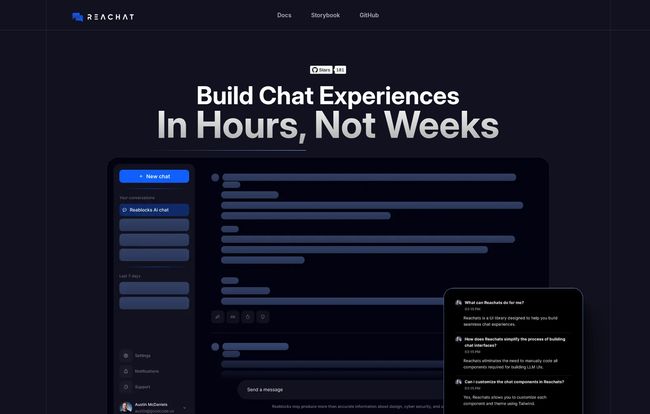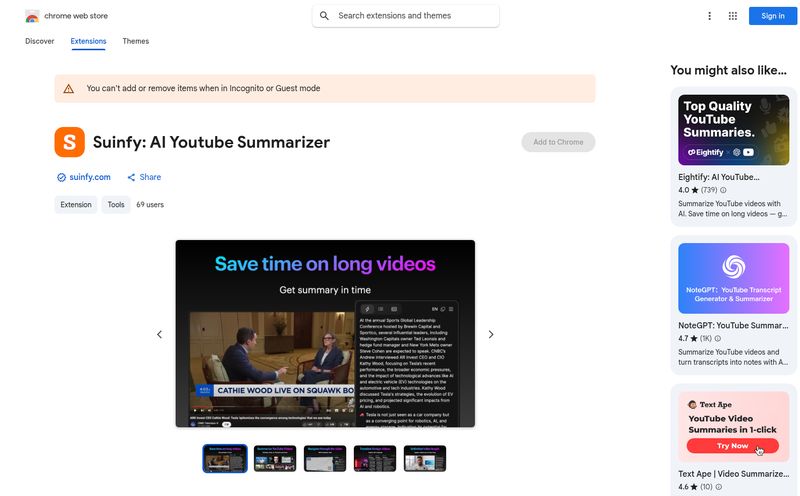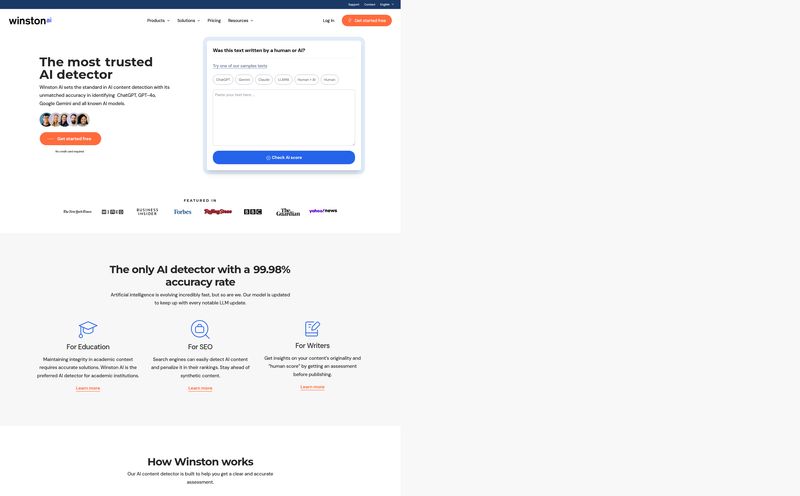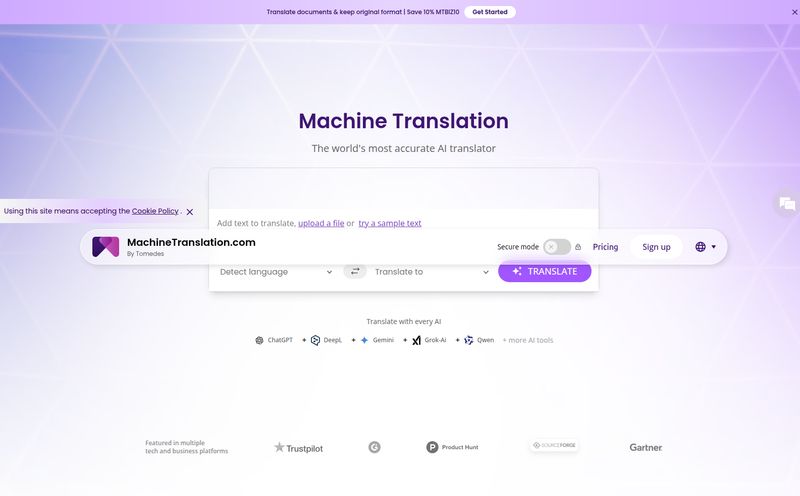If you’ve been in the web dev game for any length of time, you’ve faced the dreaded “chat feature” request. It always starts so simply. A client or a PM says, “Hey, can we just add a little chat bubble in the corner?” And you, perhaps a bit naive, perhaps a bit too optimistic, think, “Sure, how hard can it be?”
Famous last words.
Suddenly you’re wrestling with WebSockets, managing message state, handling typing indicators, read receipts, file uploads, link unfurling... and don’t even get me started on making it all look good on mobile. What was supposed to be a weekend task has now consumed three sprints, and you’re starting to question your life choices. We've all been there.
So when I stumbled upon a project called Reachat, my battle-hardened cynicism immediately kicked in. The headline was bold, almost arrogant: “Build Chat Experiences In Hours, Not Weeks.” Yeah, right. I’ve heard that one before. But, being the glutton for punishment that I am, I decided to take a look. And honestly? I’m glad I did.
So, What Exactly is Reachat?
In simple terms, Reachat is an open-source UI component library specifically for building chat interfaces with ReactJS. Think of it less as a restrictive, all-in-one framework and more like a specialized box of LEGOs. It gives you all the essential, fiddly pieces you need—the message bubbles, the input bars, the user avatars—without telling you what kind of castle you have to build.
It’s designed to be the frontend part of the equation. The pretty face, if you will. It’s not coupled to any particular backend, AI model, or database. You bring your own logic, your own GPT-4 or Claude integration, your own backend chaos, and Reachat just handles making it all look like a clean, professional chat app.
The “Hours, Not Weeks” Promise Is… Actually Plausible
This was the claim I was most skeptical about, but the getting-started process is refreshingly straightforward. The website lays it out in three steps:
npm i reachat- Include it in your project
- Connect your backend
And that’s… kind of it. Obviously, step three, “Connect your backend,” is where your own personal brand of magic (or madness) comes in. But that's the point! Reachat frees you from the tedious, repetitive work of building the UI from scratch. You’re no longer spending days figuring out how to get scroll-to-bottom working perfectly or how to elegantly display an error message when an image fails to load. You can just grab the pre-built components and focus your brainpower on the stuff that actually makes your app unique.

Visit Reachat
It’s a huge mental shift. Instead of dedicating 70% of your time to the UI and 30% to the core logic, you get to flip that ratio. For developers, that’s not just a time-saver; it’s a sanity-saver.
The Siren Song of “I’ll Just Build It Myself”
I know what some of you are thinking. “Why use a library? I’m a good developer, I can build a chat UI myself.” I get it. I really do. There’s a certain pride in building things from the ground up. But I’ve learned the hard way that the chat UI is a trojan horse of complexity.
You start with simple text messages. Then someone asks for markdown support. Then image uploads. Then video embeds. Before you know it, you're maintaining a miniature social media platform just for the UI components. Reachat seems to understand this pain. It comes with rich media support baked in, which is a massive win.
Features That Actually Matter
Going through their docs and Storybook (which is a great way to see components in action, by the way), a few things stood out to me as being genuinely useful, not just marketing fluff.
True Backend and LLM Agnosticism
This is probably the biggest selling point for me. It doesn’t care if you’re hitting a custom Node.js endpoint, a Python/FastAPI server, or directly talking to a third-party AI service. This flexibility is gold. You’re not locked into a specific ecosystem, so if you decide to switch your LLM from one provider to another, your entire frontend doesn’t need a rewrite. You just change the data source. Beautiful.
Highly Customizable and Themeable
Let’s face it, nobody wants their app to look like a generic template. Reachat components are built with customization in mind. You can tweak colors, fonts, spacing—the whole nine yards—to make sure the chat interface feels like a native part of your application, not some bolted-on third-party widget. This is a subtle but crutial detail for brand consistency.
Rich Media Support is Standard
The fact that it handles things like file uploads, embeds, and markdown without you having to install a dozen other dependencies is a huge relief. These are the features that users now expect as standard, and they are often the most painful to implement correctly and securely. Having them ready to go is a significant head start.
Are There Any Downsides?
No tool is perfect, and it’s important to go in with your eyes open. Based on my analysis, here are a few things to keep in mind:
- You Need to Know React: This seems obvious, but it’s worth stating. This is a React library. If your team is built on Vue, Svelte, or Angular, this isn’t the tool for you.
- Backend Integration is On You: While its agnosticism is a strength, it also means you’ll need to do some wiring. You'll have to write the code that handles API calls, manages authentication, and processes the data to and from Reachat's components.
- Documentation for the Edge Cases: For a relatively new open-source project, the documentation seems pretty solid for getting started. However, as with many such projects, if you have a super-advanced, niche use case, you might find yourself digging into the source code. Which, hey, it’s open source, so you can!
The All-Important Question: What Does Reachat Cost?
Here’s the best part. I went looking for a pricing page, and... it returned a 404. In the world of SaaS, that's usually a bad sign, but in the world of open source, it’s often the best sign you can get. It means the price is exactly what we developers love to hear: zero.
Reachat is open-source and free to use. It seems to be a project from a company called Cloud-Code, which is a common and fantastic model—provide a genuinely useful tool to the community for free. I have a lot of respect for that approach. It builds trust and lets the tool speak for itself.
Final Thoughts From a Fellow Dev
So, is Reachat the magic bullet for all your chat development woes? Of course not. But it’s a damn good tool that solves a very real, very annoying problem. It’s for the pragmatic developer who understands the value of standing on the shoulders of giants.
If you're starting a new React project that needs a conversational UI, or if you're looking to refactor a clunky, home-grown chat interface, I’d say giving Reachat a spin is a no-brainer. It could genuinely save you weeks of development time and a whole lot of headaches. It lets you focus on building your app's unique value, not on reinventing the chat bubble for the hundredth time.
Frequently Asked Questions about Reachat
- Is Reachat really free?
- Yes, it's an open-source library distributed under what appears to be a permissive license. This means it's free to use in both personal and commercial projects. The best kind of free!
- Do I absolutely need to be a React expert to use it?
- You definitely need a working knowledge of React and its ecosystem (hooks, state management, etc.). It's a React component library, so you'll be working within a React application. You don't need to be a top-tier expert, but a solid foundation is required.
- Can I use Reachat with any LLM, like GPT-4 or Claude 3?
- Absolutely. Reachat is completely backend-agnostic. It only cares about the data you pass to its components. You can build your backend to connect to any LLM provider, and Reachat will handle the UI part of displaying the conversation.
- Is Reachat good enough for a large-scale production app?
- From what I've seen, the components are well-built and address common needs. For many production applications, it would likely be a fantastic starting point. As with any open-source library, you'll want to do your own testing to ensure it meets your specific performance and security requirements at scale.
- How can I contribute to the Reachat project?
- The best place to start is their GitHub repository. You can open issues for bugs or feature requests, submit pull requests with improvements, or help enhance the documentation. Open-source projects thrive on community contributions.
Conclusion
In a world full of over-engineered solutions, the simple elegance of Reachat is refreshing. It does one thing—helps you build chat UIs in React—and it does it well. It’s a tool that respects your time and lets you get back to the fun parts of coding. And for that, it gets a solid two thumbs up from me. Go give it a try.
Reference and Sources
- Reachat Official Website: (The URL from the image, assumed to be reachat.ai or similar)
- Reachat GitHub Repository: https://github.com/cloud-code-ai/reachat
- Project Sponsor: https://cloud-code.ai/
- ReactJS Official Documentation: https://react.dev/



